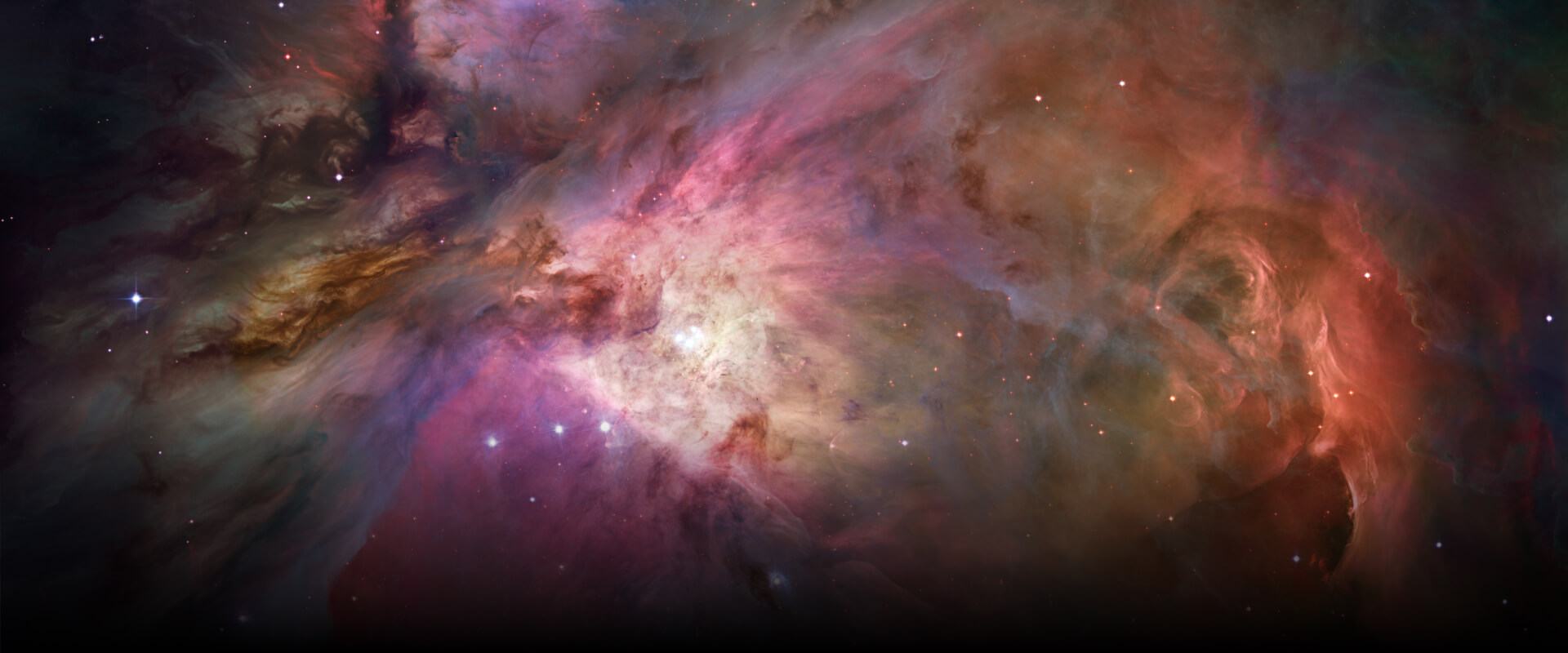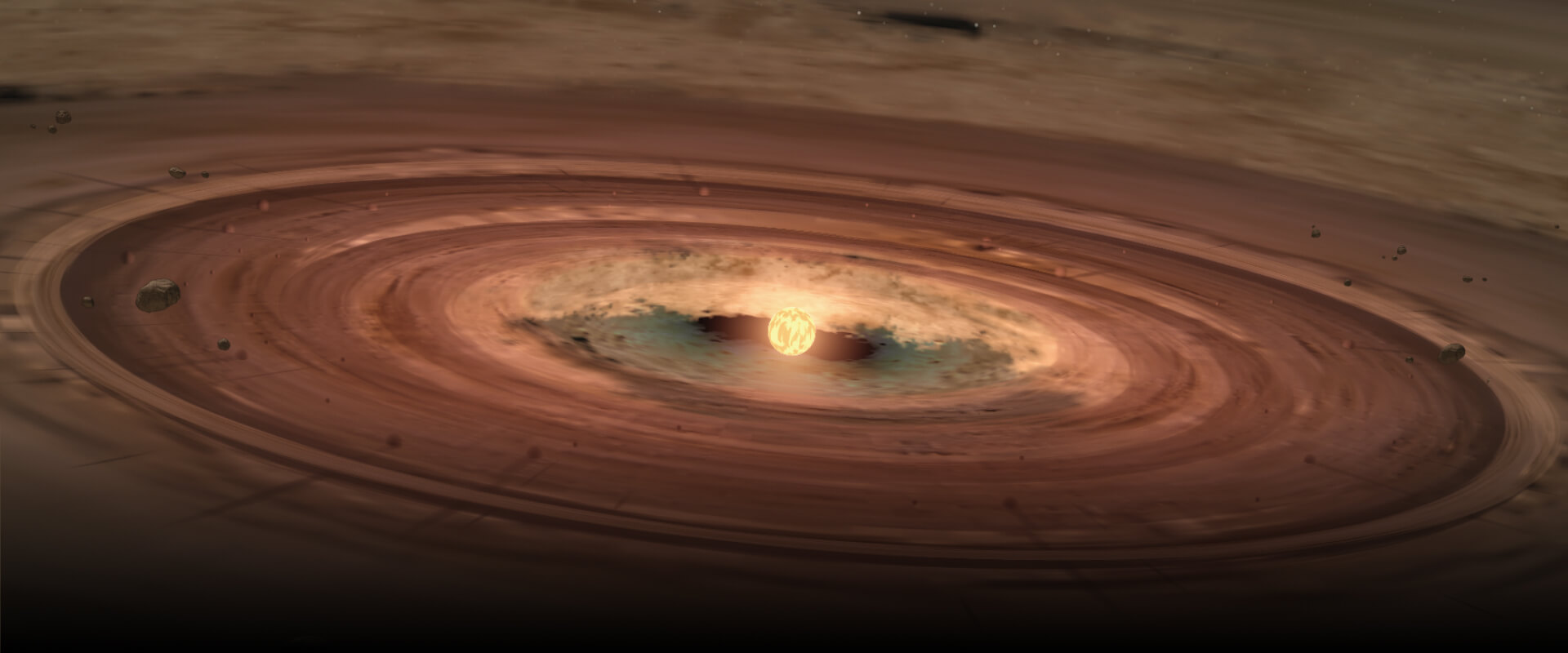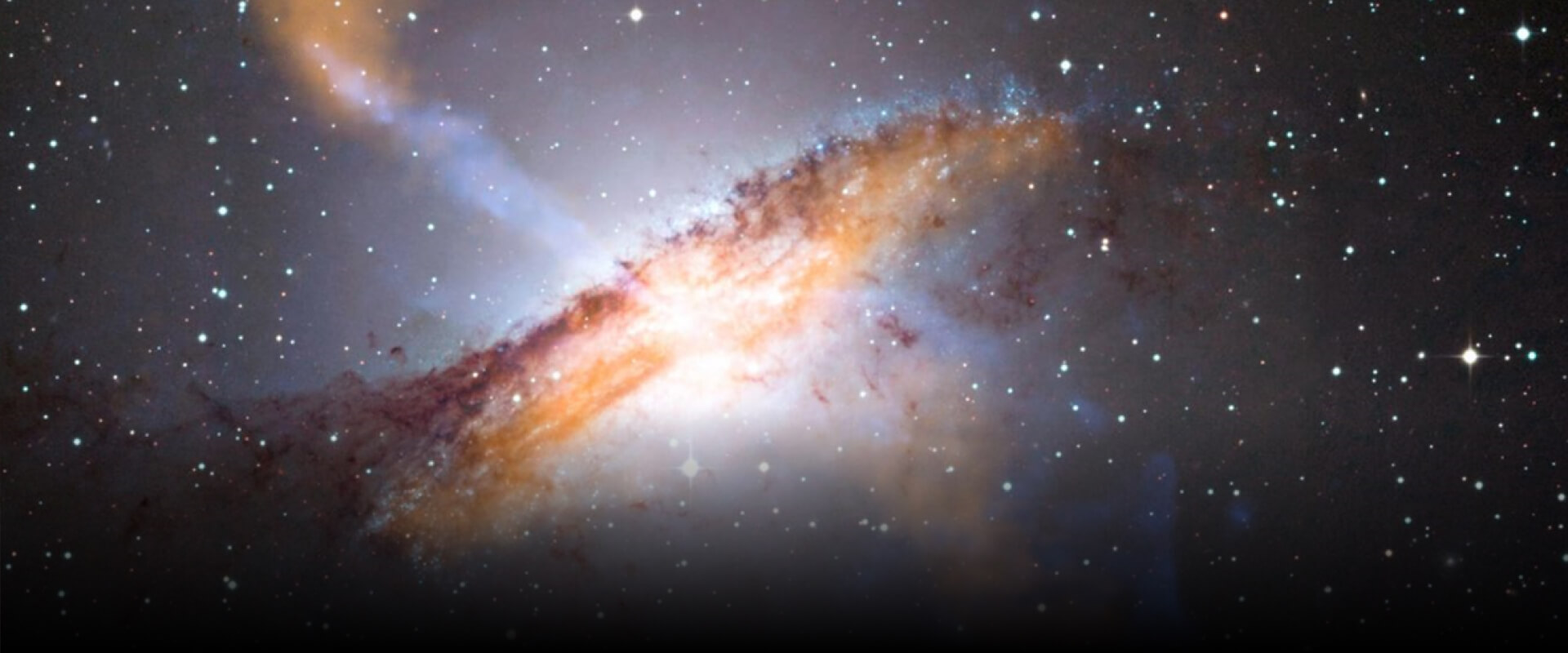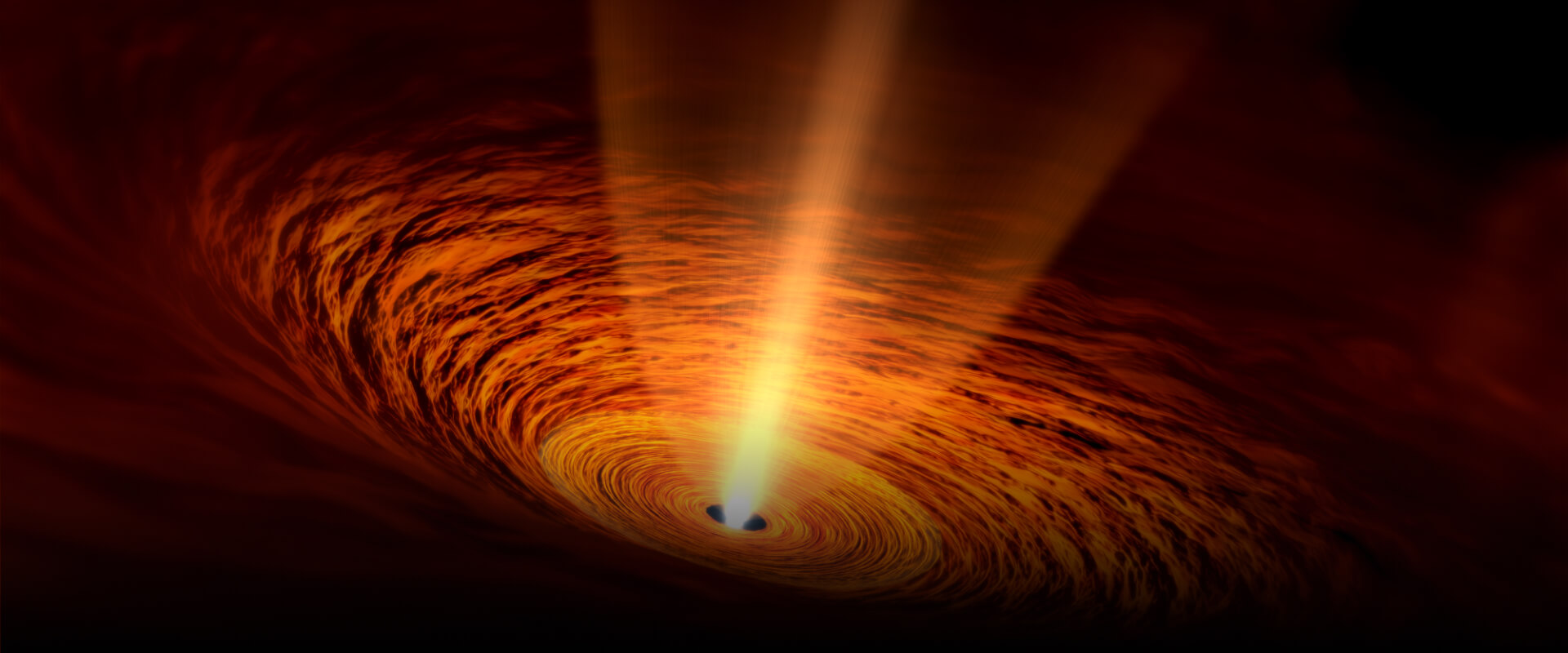Division of Science, NAOJ
“Motion of Planet-Forming Spirals Captured on Video”
Tomohiro C. Yoshida et al. “Winding Motion of Spirals in a Gravitationally Unstable Protoplanetary Disk”, in Nature Astronomy, DOI: 10.1038/s41550-025-02639-y
Neutrinos change their quantum numbers “flavors” during their propagation. Such quantum phenomena are known as neutrino oscillations whose behaviors are sensitive to background medium. It is theoretically predicted that “collective neutrino oscillations” are caused by neutrino self-interactions deep inside core-collapse supernovae. However, there is no observational evidence of such non-linear flavor conversions. It seems that collective neutrino oscillations occur actively in electron capture supernovae because of their dilute density structure compared with that of standard iron core-collapse supernovae.
Dr. Sasaki, Dr. Takiwaki and their collaborators carried out numerical simulations of both hydrodynamics of an electron capture supernova and neutrino oscillations inside the supernova. Then, they estimated event numbers of neutrinos and time evolutions of hardness ratios in future neutrino detectors such as Hyper-Kamiokande (HK) and DUNE. They found that the contribution of collective neutrino oscillations can be distinguished observationally in such neutrino detectors if the electron capture supernova occurs within 〜10 kpc.
2020/04/30
Reference:
Hirokazu Sasaki, Tomoya Takiwaki, Shio Kawagoe, Shunsaku Horiuchi, and Koji Ishidoshiro, Physical Review D101, 063027 [ADS], [PRD]
Contact:
Hirokazu Sasaki [hiro.sasaki ATM nao.ac.jp]
Tomoya Takiwaki [personal website]
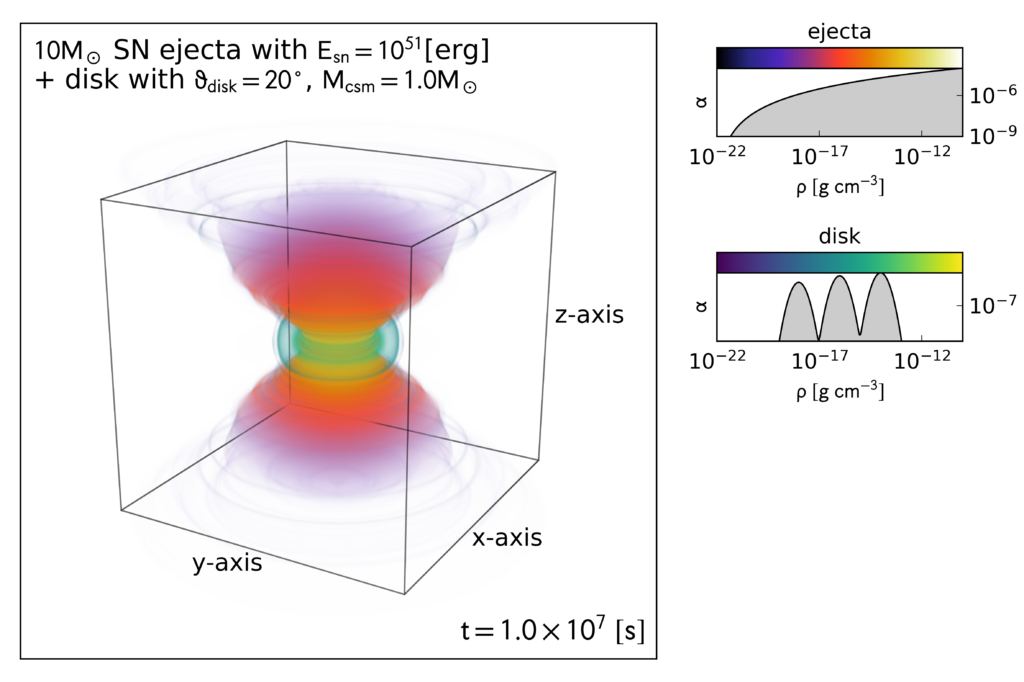
Among final explosions of massive stars(core-collapse supernovae), some objects show the evidence of the interaction with gas surrounding exploding stars (circum-stellar media). They are classified into the type IIn or Ibn sub-classes, depending on the presence and absence of hydrogen lines in their spectra (type II supernovae are those with hydrogen spectral feature and type Ib supernovae are those with no hydrogen feature but with helium). Some type IIn supernovae are thought to be powered by the collision between the supernova ejecta and the circum-stellar medium, which sometimes makes them extremely bright (e.g., SN 2006gy). However, it is still unclear how such massive circum-stellar media could be produced in the final evolutionary stage of a massive star and distributed around the star. Some type IIn supernovae exhibit asymmetric spectral line features and polarization signature, suggesting that circum-stellar media are distributed in a non-spherical way. Therefore, investigating how supernovae interacting with massive circum-stellar media outshine and detailed comparisons between theoretical models and observations may shed light on the origin of massive circum-stellar media around exploding stars.
Dr. Akihiro Suzuki (NAOJ Fellow), Dr. Takashi Moriya, and Dr. Tomoya Takiwaki of Division of Science, NAOJ performed two-dimensional radiation-hydrodynamic simulations of supernova ejecta colliding with circum-stellar media to investigate how they look like. They found that their light curves are highly dependent on the viewing angle along which observers are seeing the object. This result may explain the diversity of light curves of supernovae powered by the collision with the surrounding gas. They will conduct additional researches on the spectral formation and polarization signatures to ultimately unveil the origin of the circum-stellar environment of exploding massive stars. This result has been published in The Astrophysical Journal.
2019/01/22
Reference:
Suzuki, A., Moriya, T. J., and Takiwaki, T., The Astrophysical Journal, 880, 150 [ADS] [doi]
Contact:
Akihiro Suzuki [personal website]
A research team led by a Tohoku University geoscientist has discovered evidence of asteroidal ice within a meteorite. Performing high-resolution CT imaging of a primitive, 4.6 billion year old meteorite, the researchers discovered micrometer-sized ultra-porous regions inside the meteorite. It is highly likely that the regions were originally filled with ice, which has since disappeared to form the ultra-porous regions.
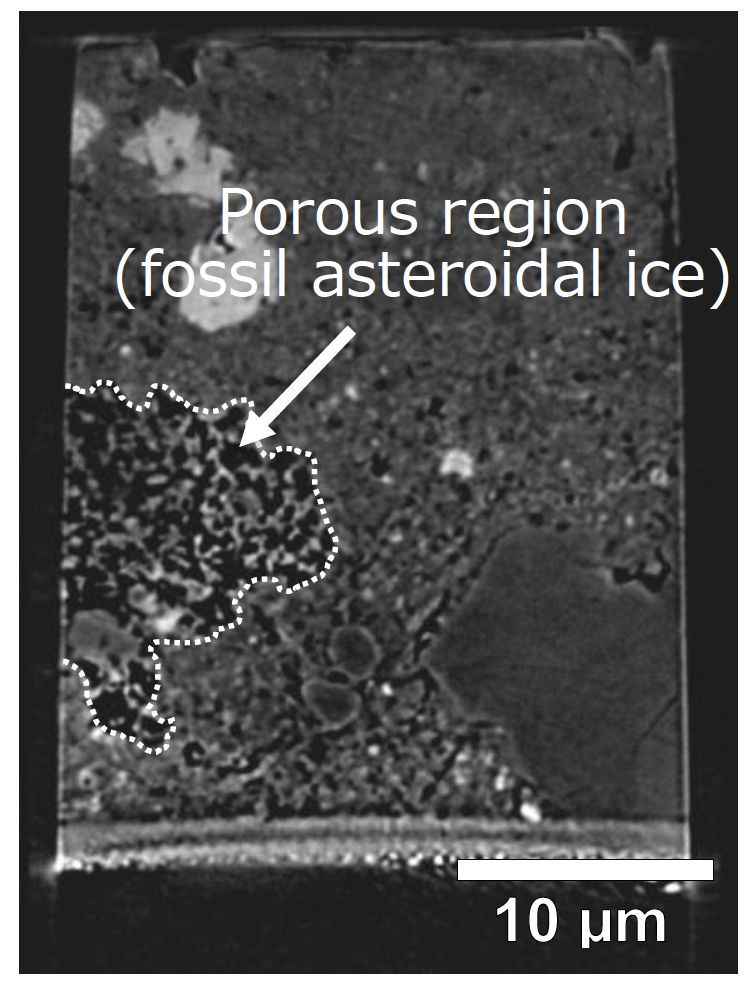
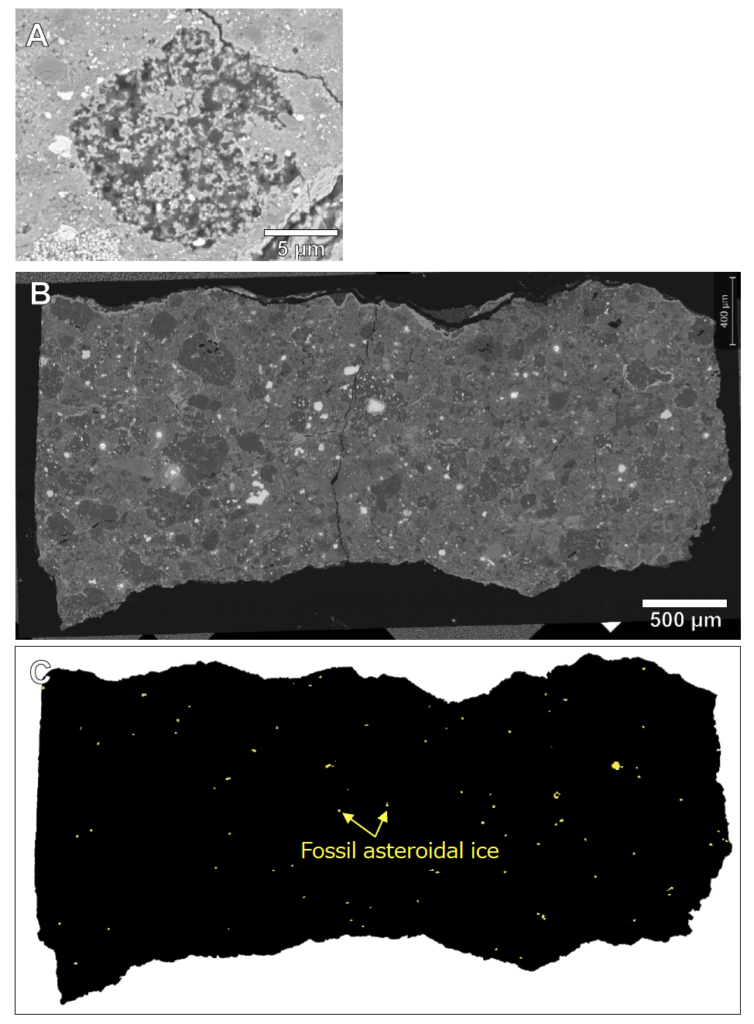
Based on the discovery, the research team proposed a new practical model indicating that the meteorite parent body (a planetesimal) formed by icy dust agglomeration through radial migration from the outer to inner regions of the early Solar System, across the H2O snow line. Their findings provide further insights into the formation of asteroids in the early Solar System.
Asteroids formed in the region outside the H2O snow line are thought to have contained some ice upon formation. It is known that there exists a large number of meteorites that seem to have experienced aqueous alteration caused by ice melting in asteroids. However, researchers have yet to discover how the primordial ice responsible for the aqueous alteration was distributed to the meteorite parent bodies.
In this study, the researchers examined a meteorite called Acfer 094. Based on their microscopic observations, they hypothesize that the ice was originally formed by the sintering of fluffy icy dust around the H2O snow line and subsequently incorporated into the meteorite parent body. The sintering process converted the fluffy icy dust into solid ice-silicate aggregates which were resistant to compaction in the meteorite parent body.
The incorporation of the aggregates into the meteorite parent body occurred around the H2O snow line during the radial migration of the parent body from the outer to inner regions of the early Solar System. After the incorporation, ice in the aggregates disappeared when an increase in temperature caused sublimation and/or melting. This resulted in the formation of ultra-porous regions inside the meteorites.
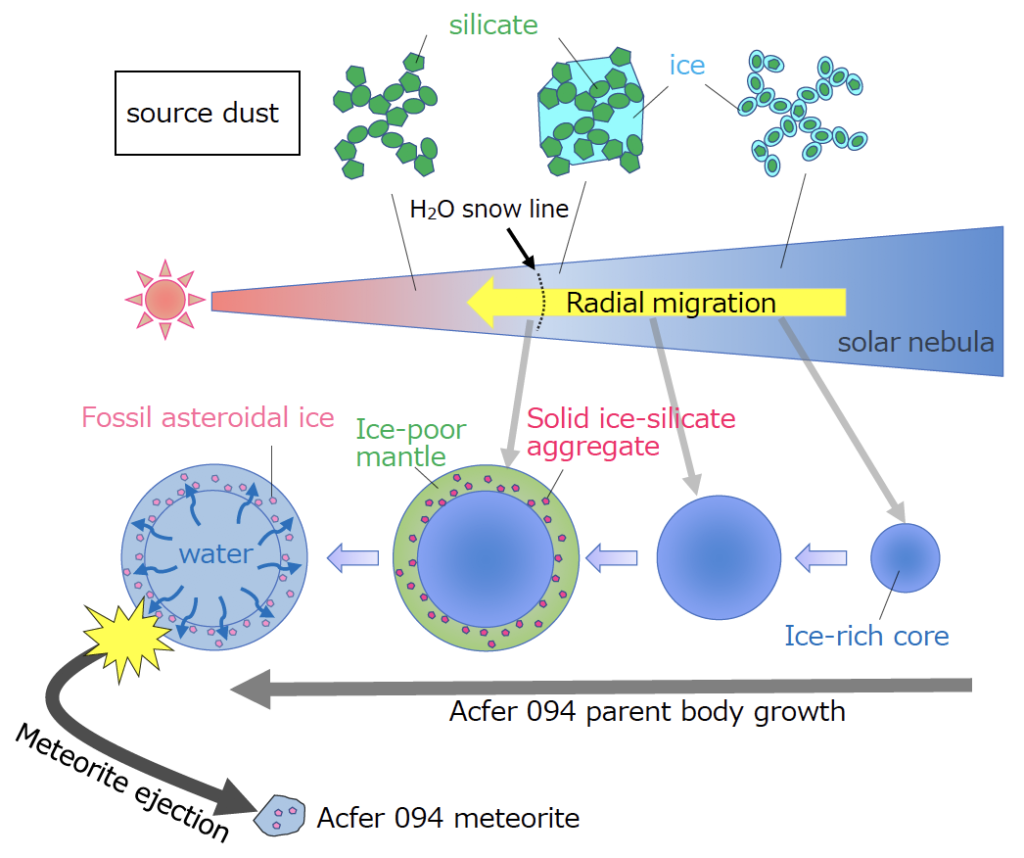
The size of porous regions in the meteorite indicates the size of the fluffy dust aggregates captured in the parent body, which provides important insight into planet formation. One of the major issues in planet formation research is how dust grains evolve to form planets. The latest theories suggest that dust aggregates of centimeter size play a crucial role in the evolution. On the other hand, radio polarimetric observations by the Atacama Large Millimeter/submillimeter Array (ALMA) indicate that the typical size of dust aggregates is about 70 micrometers. Akimasa Kataoka, a member of the research team and an assistant professor at NAOJ says “The size of the dust aggregates suggested by this research is about 10 micrometers, which is much smaller than the theoretical predictions but comparable to the size of dust aggregates suggested by the radio polarimetric observations. We would like to reveal how planets form from these tiny grains.”
These findings are important in terms of providing new insight to understand asteroid formation in the early Solar System as well as planet formation in other planetary systems. The details are described in a paper published by Science Advances online.
[Research Paper]
Title: Discovery of fossil asteroidal ice in primitive meteorite Acfer 094
Journal: Science Advances
Authors: M. Matsumoto, A. Tsuchiyama, A. Nakato, J. Matsuno, A. Miyake, A. Kataoka, M. Ito, N. Tomioka, Y. Kodama, K. Uesugi, A. Takeuchi, T. Nakano and E. Vaccaro.
DOI : 10.1126/sciadv.aax5078
[For the Use of Contents in This Website]
- Contents are to be used with a clear indication of its copyright (e.g. (c) NAOJ.)
- If you would like to use the contents found in this web site, please follow Terms of Use of the Website of NAOJ.
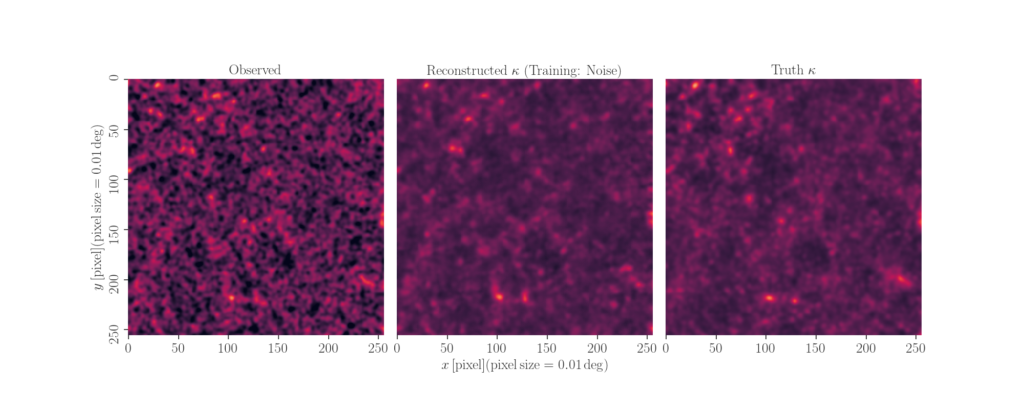
Gravitational lensing is a relativistic effect that causes characteristic distortion of the images of distant astrophysical sources. Although the induced distortion is tiny for individual sources, averaging over the shapes of many sources enables us to map the large-scale cosmic matter distribution. Wide-field galaxy surveys allow us to generate the so-called weak lensing maps, but actual observations suffer from noise due to the imperfect measurement of galaxy shape distortions and to the limited number density of the source galaxies.
Dr. Masato Shirasaki (Division of Science, National Astronomical Observatory of Japan), Prof. Naoki Yoshida (Univ.of Tokyo) and Prof. Shiro Ikeda (The Institute of Statistical Mathematics) explore a deep-learning approach to reduce the noise. They develop an image-to-image translation method with conditional adversarial networks (CANs), which learn an efficient mapping from an input noisy weak lensing map to the underlying noiseless field. They train the CANs using 30000 image pairs obtained from 1000 ray-tracing simulations of weak gravitational lensing. The figures show an example of image-to-image translation by the networks. The left panel shows an input noisy lensing map, while the right is for true (noiseless) counterpart. The medium represents the reconstructed map by their networks. In this figure, a brighter (darker) region corresponds to a higher (lower) matter density. In the paper, they investigate the robustness of the deep-learning method to de-noise the lensing map and propose to use the de-noised map for cosmological analyses.
2019/08/19
Reference:
Shirasaki, M., Yoshida, N., Ikeda, S. Physical Review D, 100, 043527 [ADS] [doi]
Contact:
Masato Shirasaki [reserchmap]
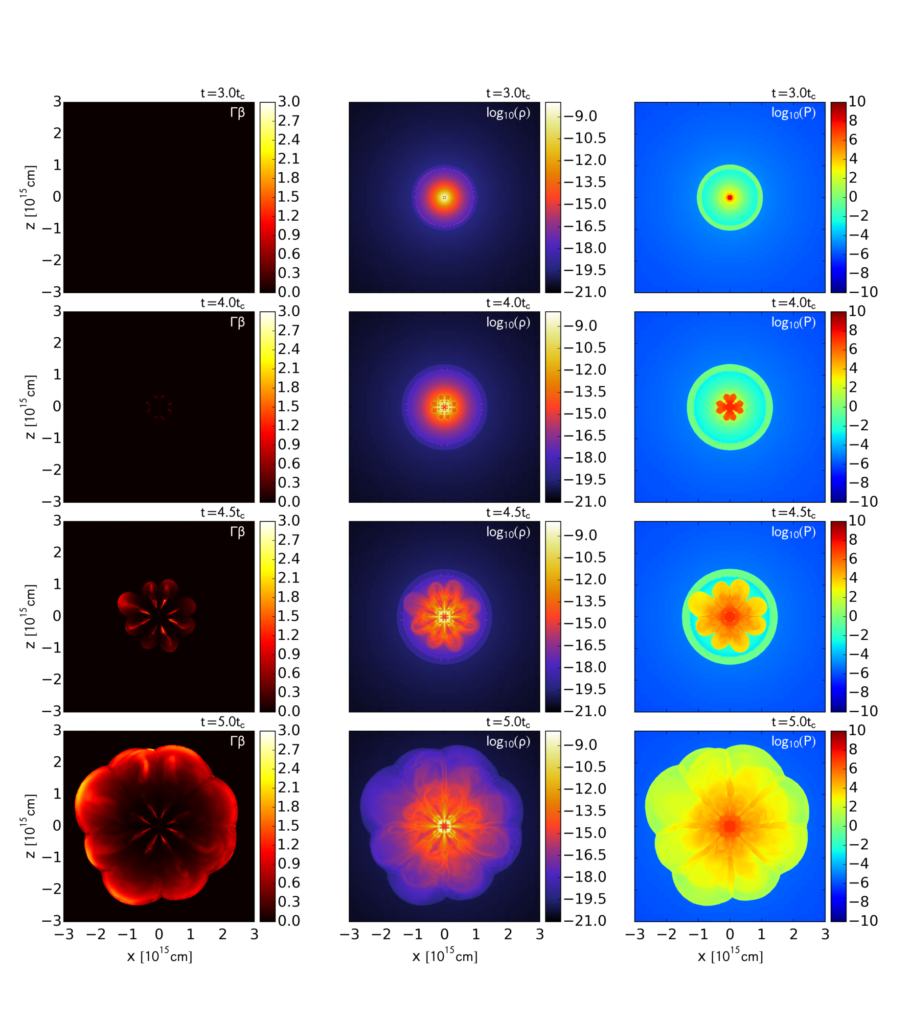
Core-collapse supernovae (SNe) sometimes show extreme brightness (superluminous SNe: ~10-100 times brighter than normal SNe) and/or huge explosion energy (broad-lined type Ic SNe: ~10 times more energetic than normal SNe). However, their origin remains unclear. One of the proposed models for these extreme events is “central engine scenario”, in which a high energy compact object left after the explosion deposit additional energy into the surrounding ejected matter (SN ejecta) to make it bright.
Dr. Akihiro Suzuki (Division of Science, National Astronomical Observatory of Japan) and Prof. Keiichi Maeda (Kyoto U.) have carried out 3D special relativistic simulations based on this central engine scenario. They found that SN ejecta with a sufficiently powerful engine experience efficient mixing between stratified layers in the ejecta. This result suggests that SN ejecta with a sufficiently powerful engine have an advantage in explaining some observational features of energetic SNe, such as broad emission/absorption lines in their spectra.
2019/08/15
Reference:
Suzuki, A. and Maeda, K., The Astrophysical Journal, 880, 150 [ADS] [doi]
Contact:
Akihiro Suzuki [personal website]
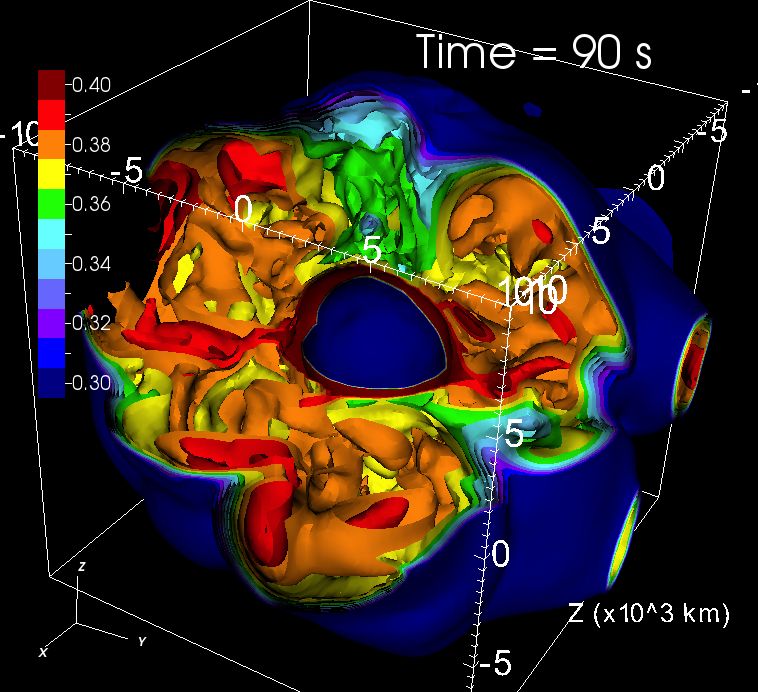
Dr. Takashi Yoshida (University of Tokyo), Dr. Tomoya Takiwaki (Division of Science) and their colleagues have been successful in a three dimensional simulation of O-shell burning phase just before the core-collapse of a massive star. A strong turbulence whose Mach number of 0.1 is found in the simulation. The figure depicts the mass fraction of Si. The turbulence makes anisotropic density distribution and that can promote a vigor explosion of core-collapse supernovae.
In this study, they first performed 100 of 1D simulations with changing stars’ initial masses and other parameters. After that they picked up 11 models and performed 2D simulations. They found preferable environment to make strong turbulence. The environment is O layer which contains a lot of Si that located at about 1000 km. The result of the 3D simulation is compared with that of 2D simulations. They also found that the energy spectrum of 3D simulation is different from that of 2D simulation.
2019/08/13
Reference:
Takashi Yoshida, Tomoya Takiwaki, Kei Kotake, Koh Takahashi, Ko Nakamura, and Hideyuki Umeda,The Astrophysical Journal, in press [ADS], [ApJ]
Contact:
Yoshida, Takashi [orcid]
Takiwaki, Tomoya [personal website]
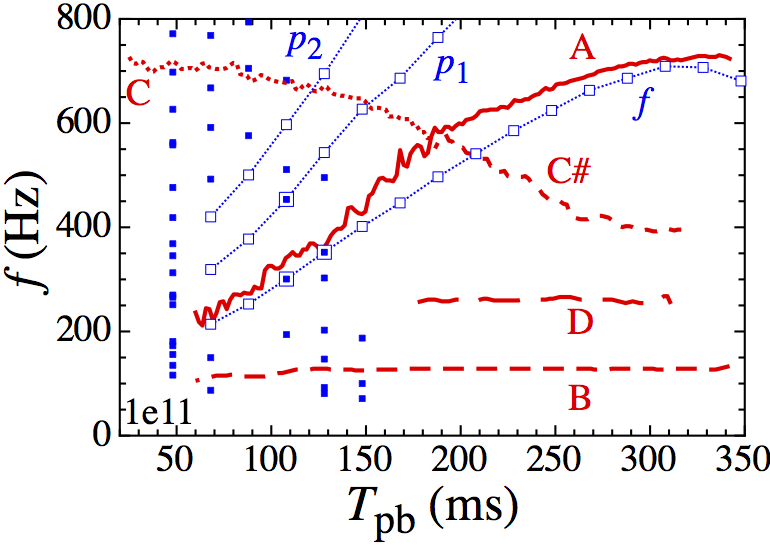
Core-collapse supernovae are target of multi-messenger astronomy. The neutrinos and gravitational waves are emitted at the explosion in addition to the photons. Detection of such signals is expected to provide essential clues to understand their explosion mechanism.
Dr. Hajime Sotani, Dr. Tomoya Takiwaki and their collaborators analysed the modes in the proto-neutron star using technique of asteroseismology. They found that one of the most important mode of gravitational wave could be interpreted as a f-mode activity of proto-neutron star. That mode is usually considered as a surface g-mode.
Though the frequency of that gravitational wave signal tells us the radius and mass of the proto-neutron star, the f-mode and surface g-mode predict different frequencies. To clarify the origin of the mode, we need more models and update of the analysis method.
2019/07/29
Reference:
Sotani, Hajime; Kuroda, Takami; Takiwaki, Tomoya; Kotake, Kei, Physical Review D, Volume 99, Issue 12, id.123024 [ADS], [PRD]
Contact:
Sotani, Hajime [orcid]
Takiwaki, Tomoya [personal website]
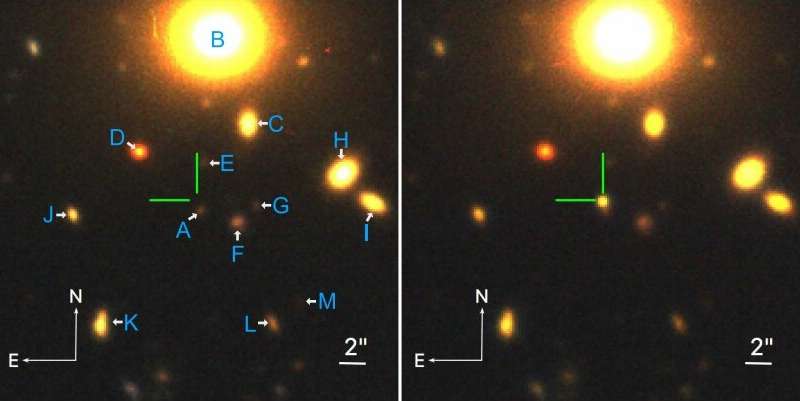
A paper on a strange supernova by Dr. Takashi Moriya was picked up by phys.org.
An unusual supernova HSC16aayt (SN 2016jiu) was discovered by the Subaru/Hyper Suprime-Cam SSP transient survey. While usual supernovae reach their peak luminosity in about a month, HSC16aayt had an unusually long rising time lasting for more than three months. It showed signatures of the interaction between supernova ejecta and dense circumstellar matter. An unusual circumstellar property of the progenitor shortly before the explosion is likely related to the unique feature of this supernova.
See the webpage of phys.org for the details.
This paper was accepted by The Astrophysical Journal [arXiv]
Contact:
Takashi Moriya [personal website]
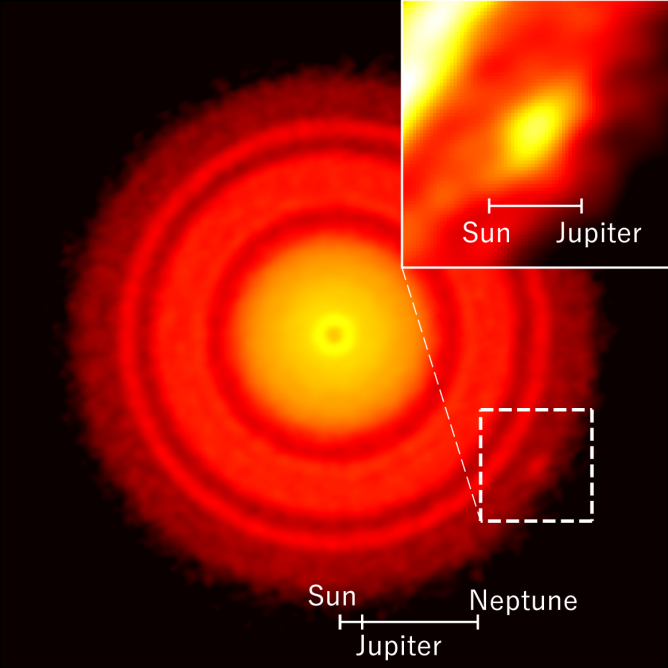
Takashi Tsukagoshi and his collaborators used ALMA and found a small dust concentration in the disk around TW Hydrae, the nearest young star. It is highly possible that a planet is growing or about to be formed in this concentration. This is the first time that the exact place where cold materials are forming the seed of a planet has been pinpointed in the disk around a young star.
See the press release in ALMA website for detail.
(2019/6/26)
Tsukagoshi et al., 2019, ApJL, Volume 878, Issue 1, article id. L8, 6 pp. [ADS]
Takashi Tsukagoshi (researchmap personal page)
